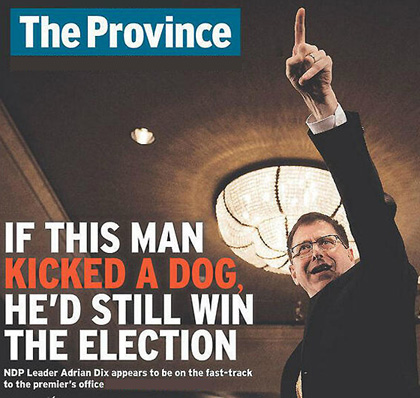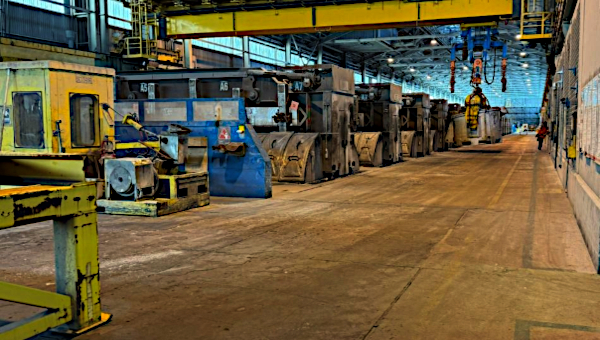The May 14 general election in British Columbia was a setback to progressive political forces in the province and throughout Canada. The incumbent BC Liberals won a fourth straight term, winning 49 seats with 44 per cent of the vote, compared to 34 seats and 40 per cent for the opposition New Democratic Party.

Big business scored a lucky win. Every single opinion poll before and during the campaign had the NDP comfortably winning a majority government. Somehow, the party managed to lose. Its vote count increased only marginally, by some 20,000 votes compared to the previous election in 20091 Just under half of eligible voters cast a ballot, meaning that Premier Christy Clark’s government was re-elected by 22 per cent of the adult population.
The result is a blow to the environmental movement across the continent. The central plank in the Liberals’ election platform was full steam ahead on coal and natural gas extraction in the province as well as a broader plan to make the BC coastline an export platform for the massive carbon reserves of western North America.
Serious Implications
The BC Liberal Party is a coalition of liberals and conservatives. It has a long history of overseeing the pillage of the province’s forest, fishing, mineral and water resources. Along with its federal counterparts in the Conservative and Liberal parties, its attention has shifted big-time to promoting the production and export of fossil fuels.
Production is surging in BC’s coal and natural gas fields, as in the Alberta tar sands and the coalfields of the western United States. This greatly enhances the attractiveness to Canadian and U.S. capitalists of BC’s Pacific Coast as an export outlet fed by pipelines and railways.
A new report by the Sightline Institute in Seattle describes what is at stake. The report looks at the 16 new or expanded fossil fuel transport projects to the coastlines of British Columbia, Oregon and Washington, consisting of seven coal terminals, three oil pipelines and six natural gas pipelines. Eleven of the 16 projects are in British Columbia.
“Taken together,” says the report, “these projects would be capable of delivering enough fuel to release an additional 761 million metric tons of carbon dioxide into the atmosphere each year, equivalent to seven Keystone XL pipelines.” (For details on fossil fuel projections for the Pacific Northwest, including massive expansion of natural gas fracking in BC, see my recent article, “All signs point to deepening opposition to the fossil fuel industry assault in British Columbia.”)
Fossil fuel capitalism is transforming the urban framework of Vancouver. Public transit suffers while billions of dollars are being spent to expand the network of roads, bridges and railways in the region to serve commercial and commuter transport. More is to come, including a proposal to replace the Massey highway tunnel under the Fraser River with a bridge that would open the lowest reaches of the river, the largest salmon-bearing river in the world, to larger, ocean-going ships. The shallow depth of the tunnel, completed in 1959, currently limits the size of ships that can sail upriver. One of the coal proposals is for a new shipping terminal to be built on the lower Fraser.
A similar rush for spoils profoundly scarred the forests of BC and of western North America during the past century and contributed to the explosion in recent years of the calamitous mountain pine beetle epidemic. A combination of decades of destructive, clear-cut logging practices and rising global temperatures has unleashed an exponential rise in the insect’s population and range.
The battle to limit the beetle’s spread and voracious appetite is all but lost in the mountain ranges of western North America. Seventy five per cent of BC’s vast pine forests, for example, have fallen. The insect has recently jumped its natural barrier along the Rocky Mountains and entered Alberta. Canada’s boreal forest now stretches before it, all the way to the Atlantic Ocean with the only natural barrier being extremely cold winter temperatures.2
Public Service Workers and Their Unions
The election also has serious implications for public sector workers and the services they deliver. The Liberals have imposed harsh austerity measures, particularly during their 2001-05 term. Spending cuts have damaged education, health care and social services. Workers have suffered cuts to salaries, benefits and conditions of work, especially those tens of thousands whose jobs have been privatized or rendered “temporary.”
The province has the highest rate of child poverty in Canada. It also leads Canada in per capita injection drug use and HIV infection. A recent novelty is the rise of children injured on the job, a consequence of the changes in child labour laws in 2003 that allow children as young as 12 to work in factories, construction and resource industries!3
Popular expectations for an NDP government were not high. NDP leader Adrian Dix specifically stated that as premier, he would not undo the Liberal legacy or even restore part of what has been lost. But labour, environmental and Aboriginal activists nonetheless saw the election of the NDP as a way to stave off further attacks on social services and perhaps slow the pace of the assault on the natural environment by the fossil fuel, forestry, mineral and fishery barons.
Joey Hartman, president of the Vancouver and District Labour Council, told Vancouver Co-Op Radio’s W2 Media Mornings, “We knew that, whoever won, we were going to really have to keep pushing the agenda. We just thought it was going to be a more receptive government.”
Stewart Phillip of the Union of BC Indian Chiefs told the same program, “Needless to say, we’re greatly disappointed. We were looking forward to a change for the better, so to speak,4 and clearly that did not materialize.”
The NDP Campaign
The NDP went into the election campaign with an exceptionally weak platform, not very different from that of the Liberals. It ran what it called a “positive” campaign, eschewing attacks on its opponent. The party spoke little of the 12-year record of the Liberals in power.
The strategy was baffling, considering the highly unpopular actions of the Liberals. Among these was the “harmonization” of federal and provincial sales taxes immediately after the 2009 election. That imposed several billion dollars of increased taxes.
The Liberals had specifically pledged during that election not to undertake such a measure. Its deception unleashed a whirlwind of anger and organized opposition, obliging the Liberals to yield to an extraordinary mass, petition campaign and convene a referendum in August 2011.
The tax was defeated, at great cost and inconvenience to large and small businesses. Support for the Liberals sank so low amidst that debacle that Premier Gordon Campbell resigned. (He was subsequently rewarded by the federal Conservatives with an appointment as Canada’s High Commissioner to the United Kingdom.)
Another Liberal stinker was the corruption and nepotism that accompanied the 2003 privatization of BC Rail, once the third largest railway in Canada. The unseemly details were eventually revealed during the third Liberal term in office, but they barely registered in this election.
What explains the lacklustre campaign by the NDP?
Adrian Dix became NDP leader in early 2011 through an insiders’ coup that ousted Carole James as leader. She was accused of softening the party’s program in order to appeal to business, thereby weakening the party’s appeal to the working-class.5
The May 2011 electoral breakthrough of the federal NDP then prompted a rethink among Dix and his leadership colleagues. They concurred with federal party leaders who attributed the breakthrough to the party’s ongoing moderation to the right pursued by federal leader Jack Layton. Key federal advisors, including Brian Topp, were part of managing the 2013 BC campaign.
In reality, the party’s 2011 gains were overwhelmingly a result of the huge swing of restless and disenchanted voters in Quebec against the Tories, Liberals and Bloc Québécois, parties to the right of the NDP. The latter was perceived as an ally in English-speaking Canada in the defense of social programs as well as sympathetic to the national aspirations of the Quebecois.
Although the Dix-led NDP was on record against Enbridge’s Northern Gateway pipeline from Alberta to the BC coast, it was waffling on another tar sands project – the expansion of Kinder Morgan’s Trans Mountain line to Vancouver. Dix said a “made in BC” environmental review process should decide the matter.
But in mid-campaign, he announced that the NDP now opposed the ninefold increase in oil tanker traffic that the project would bring to the port of Vancouver. This was a response to pressure from a broad array of environmental forces as well as municipal politicians in the Vancouver region.
It was also prompted by a perceived surge in popular support for the Green Party. In the end, the Green vote did not increase over 2009, but the party scored a breakthrough in southern Vancouver Island, winning its first seat ever in the Legislature and coming very close in another district.
Big business mouthpieces, including the Liberals, jumped all over what they called a “flip-flop” by Dix. They said it harkened back to the bad old days of NDP governments in the 1970s and 1990s when the NDP took moderate measures encroaching on capitalist prerogatives.
Some trade unions in the province concurred with big business. Tom Sigurdson, head of the BC and Yukon Territories Building and Construction Trade Council, says his group supports tar sands pipelines and was disappointed by Dix’s pronouncement. Steve Hunt, western director of the Steelworkers, says Dix made a “significant mistake.” Bending to the pressure, Dix told a post-election press conference on May 22 that his pronouncement “hurt our campaign.”
Voter Apathy?
In the wake of the disappointing election result, many critics on the left have objected to the “positive” pitch of the NDP campaign.
Dix and the party leadership say they wanted to counter the increasingly harsh tone of capitalist politics. They note, correctly, that it discourages and effectively disenfranchises marginal voters. The majority of discouraged voters are poor and working-class people. While right-wing voters had the option of an aggressive Liberal Party or an even more right-wing Conservative Party (it took 5 per cent of the vote), left–wing voters had only two choices: the NDP or the Greens, each of which have platforms entirely consistent with pro-capitalist, neoliberal politics.
But the problem with the NDP campaign was not the tone but the content. The party simply failed to offer a real alternative to the electorate. The result? Voter turnout in this BC election was only marginally higher than 2009’s record low, continuing a downward trend in electoral participation that has marked Canadian politics, with few exceptions, for several decades.
Marissa Lawrence of Simon Fraser University studied voter participation during the BC election with two projects – SFU Public Square and Samara. She explains in an op-ed published in the Vancouver Sun that young people are “definitely not apathetic.” But participants in her groups’ studies saw no incentive to participate in the electoral process “when elected officials appear unable or unwilling to engage constructively. They believe decisions are already made, and don’t connect change to the ballot box. BC participants have expressed their frustrations with elected officials’ lack of accountability, not only to their campaign promises, but also to their elected term.”
A recent letter writer to the Sun explained,
“We have low voter turnout because most non-voters are well aware that with our first-past-the-post electoral system, their votes are likely to amount to nothing or very little. And they’re right…. It’s patronizing to suggest that more education is needed to improve voter turnout. Our electoral system is broke and needs to change, period.”
Some observers point to the success of NDP election campaigns in the 1970s and 1990s when the party offered criticism of big-business and proposed modest reforms. However modest those may have been, they were certainly stronger than anything heard recently from the party.
Trade unions in the province, many of which are affiliated to the party, endorsed the soft-pedaling by the NDP. They agreed to remove their specific interests and concerns from the NDP campaign and not campaign independently in the electoral arena, effectively hoping that voters would sleepwalk into the election of an NDP government.
What Now?
Would a more aggressive and left wing campaign by the NDP have won this election for the party? One hopes this will be seriously debated in the unions and the environmental movement in the weeks and months to come. There is lots of anecdotal evidence to suggest the answer is “yes”:
- Green Party support surged in southern Vancouver Island where concern over increased tar sands and coal shipments is high. The Greens took clear stands against both. (Its stand on the equally bad expansion of natural gas production and shipment was, sadly, less evident.)
- Two NDP candidates in very tight contests in Vancouver who identified as strong environmentalists opposed to the tar sands won their seats, including David Eby, a well-known human rights advocate who toppled Premier Clark in her own riding.
- The highest voter participation by far was scored in Comox Valley on Vancouver Island. There, a central issue was the proposed Raven coal mine. The pro-mine Liberals narrowly won the seat against a divided NDP-Green vote, but thanks to several years of hard campaigning by mine opponents, the mine project was rejected by BC’s Environmental Assessment Office on May 16.
- Vicki Huntington, an independent candidate in South Delta (Vancouver region) who is viewed as an opponent of unfettered road, rail and port development, won re-election with a wider mandate.
Even if an aggressive left wing campaign did not win the election, it would have left progressive movements in a stronger position than now exists.
Some union and other activists in the province are beginning to speak and write about the challenges now lying ahead, including the strengths from pre-election struggles that can be built upon.
Indigenous leaders, including Art Sterritt of Coastal First Nations, note that the wall of opposition to the Northern Gateway pipeline remains unbreached.
Grand Chief Stewart Phillip explained in the interview cited earlier,
“As I watched the results unfold, I began to realize that we are, in all likelihood, moving toward an era of confrontation and conflict, given the fact that under Premier Clark’s leadership there was no effort to invest in any significant or genuine way in terms of building a closer with the Indigenous peoples of this province.”
Awareness and opposition is growing to the Trans Mountain pipeline and to coal expansion. Two days following the election, for example, a first information meeting took place in South Surrey to discuss and plan opposition to increased coal shipments by rail through that community. It was attended by 75 people, including a speaker from Washington state who explained that campaigners there and in Oregon have recently succeeded in blocking three of six coal terminal proposals on their coastlines.
A rally to pressure the Board of Metro Vancouver to oppose plans for increased coal shipments through the Port of Vancouver is planned for May 25.
The future of public education services will soon come to the fore as collective agreement negotiations open between the new government and the BC Teachers’ Federation. The union signed an unsatisfactory, one-year agreement last year and hoped that it would be negotiating this year with an NDP government. The key issue in dispute will be the declining conditions of public education, including large classroom sizes.
Tara Ehrcke, an education activist and current president of the Greater Victoria Teachers’ Federation, offered this view of the election in her blog, Staffroom Confidential:
“My greatest disappointment about this election was not the outcome, but the fact that not a single party stood up and spoke out for a radical re-evaluation of the massive inequity in our society. No political party really spoke to the need to tax the wealthy and to reinvest that money in services that benefit everyone, collectively.”
She continued,
“I am not disappointed this week. I am hopeful that those wanting genuine change will give some serious thought to reevaluating strategies that put all hope into electing a supposedly, but not actually, labour and social movement friendly government. Instead, we need to be building networks of activists on the ground and in our communities.” •





